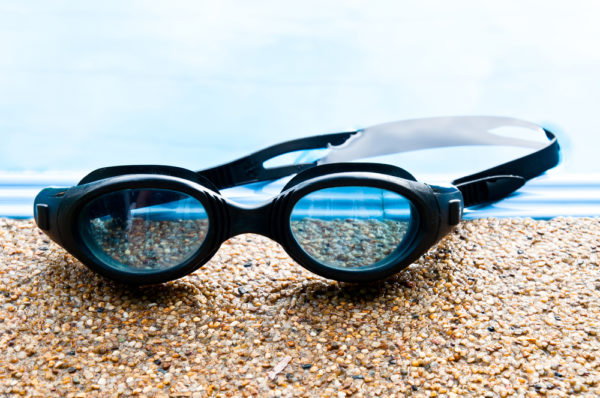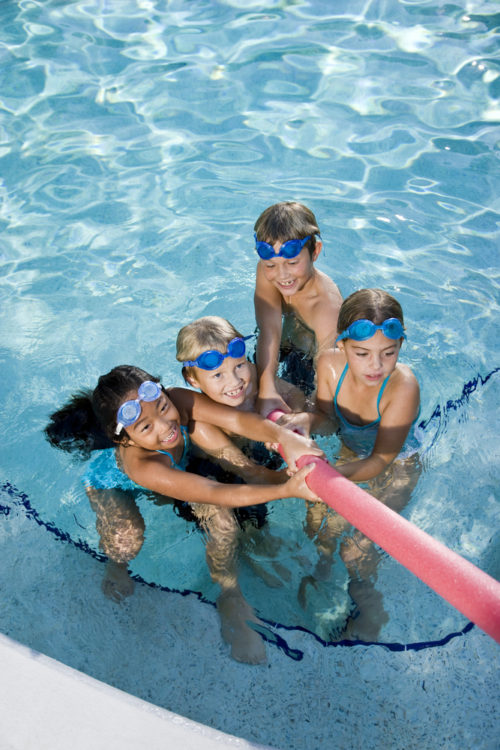
The cruise ship pool area can be one of the most fun places on the ship for kids, particularly if you are sailing on one of the newer ships with awesome waterslides. (See this ship report for an example.) But one thing to keep in mind while you are indulging in all the fun that the cruise ship has to offer is water safety for kids. As the high volume cruise season fast approaches, now is a good time to consider some basic pool safety tips and water safety for kids as you embark on your next family adventure.
While drownings on cruises do not occur frequently, it is still something that can and should be avoided. Relaxing in a fun family-filled pool sailing across the ocean may seem like a relatively safe venue, but some vigilance remains necessary. Follow these 5 pool safety tips to keep your kids and family safe.
1. Know the Actual Role of Cruise Ship Personnel.
A large cruise ship usually has thousands of personnel performing various functions designed to enhance your vacation experience. However, very few – if any – of them will be focused on your safety around the pool. Just because you see someone who appears to be “on duty” walking around the pool area, do not assume that person is a lifeguard. That person may be a monitor, attendant, or someone who is focused on attending to waterpark activities. They generally assist guests with non-urgent issues and enforce relevant rules. While some of the rules promote water safety for kids, these crew members are not necessarily professionally trained to aid people in distress. And, more important, the focus of their job is not to actively watch the pool area for people in distress.
Please be aware that few cruise lines employ actual lifeguards. Lifeguards have only been a recent addition to cruise ship swimming pools, and they are still not a common feature. A “comprehensive” list of cruise lines that have lifeguards consists of three lines — Disney, Royal Caribbean and Norwegian. Disney added lifeguards to its fleet in 2013. Royal Caribbean made the decision to add lifeguards to its fleet in 2017. And, Norwegian joined the (small) bandwagon later that same year. Norwegian added lifeguards to four ships (Escape, Getaway, Epic and Breakaway) in 2017 and plans to roll out to the entire fleet during 2018.
Notably, Carnival has affirmatively stated that it has no plans to add lifeguards to its fleet. And, the Miami Herald describes Carnival as: “now the only major cruise line without lifeguards, despite often touting that it’s the cruise line that ‘sails the most families,’ including a large number of children.” Read more here and here.
2. Water Safety for Kids Means Use Eyes Not Just Ears.
If you are in the pool area with the goal of supervising the safety of your kids, you need to rely on your eyes and not only your ears. You know how in the movies or TV, the drowning person thrashes around, yells for help, and otherwise makes a real commotion? Well, apparently that rarely happens in real life.
As a U.S. consumer safety official told Cruise Critic: “Drowning is quick and it is silent — it does not look like it does in the movies with arms flailing and cries for help. Unfortunately, we see too many children who drown in crowded pools that are full of other children and adults.”
In short, don’t assume you will hear your child in distress. A designated adult must keep his or her eyes on the kids and not on a book, magazine, cell phone, another adult, or the line at the ice cream bar.
Signs of Potential Drowning
Here are some shorthand signs to watch out for. If you see any of these, you should check on the kid and make sure she can answer the question: “Are you alright?”
- Silent child with shocked, concerned or panicked expression
- Child in largely vertical position with head tilted back (trying to get air)
- Actual hyperventilating or gasping
- Head low in the water with mouth at water level
- Arms moving downward in the water like he is trying to grab something
- A kid who jumps in the water but doesn’t pop back up within a few seconds
For a more detailed article explaining the signs of the Instinctive Drowning Response, check out this helpful Slate article. And, for more on how to spot a child in distress in the pool, check here.
3. Maintain Vigilance Even When Lifeguard On Duty.
Don’t allow the crowded nature of the pool to provide a false sense of security. It is highly unlikely that strangers -even caring friendly ones – will pay sufficiently close attention to your child, or necessarily notice if your child gets in trouble.

It can be very hard for a casual observer to notice drowning kids. As noted above, there is often no obvious thrashing or cries for help. Their bodies are too busy trying to breath. Check out Can You Spot the Kid Drowning in This Public Pool Before the Lifeguard Does? for a good example as to how easy it is for a distressed child to go unnoticed.
4. Flotation Gear Can’t Replace Active Adult Supervision.
Flotation devices for kids have now become very common around public pools. Indeed, both Disney and Royal Caribbean offer complimentary swim vests for children for use on board. And, Norwegian plans to offer that amenity as well.
That’s a great service that definitely supports increased water safety for kids. However, it is important to not be overly reliant on such devices. All leading experts on pool safety caution that true water safety for kids requires active adult supervision. Check out these articles here, here, and here. You, or another adult in your party should plan to stay within arm’s reach, even if your child has a vest or access to a floatie.
And, for a great infographic from Mom Loves Best that summarizes all of the key facts you should know about water safety this season, click here.
5. Don’t Allow Young Children in the Water Alone.
Finally, you should not allow young children in the water alone, even if you believe they know how to swim. Sadly, the statistics on this are quite grim. Drowning is the second leading cause of accidental death for children under age of 5. And, it is in the top 10 for kids under the age of 15. Remember, it can take less than 5 minutes for a kid to drown. (Check out our post on other cruise ship deaths.)
In sum, staying nearby with your eyes open is the best pool safety defense to unfortunate accidents.
Will you be sailing with young children this year? Grab our special checklist to prepare!
